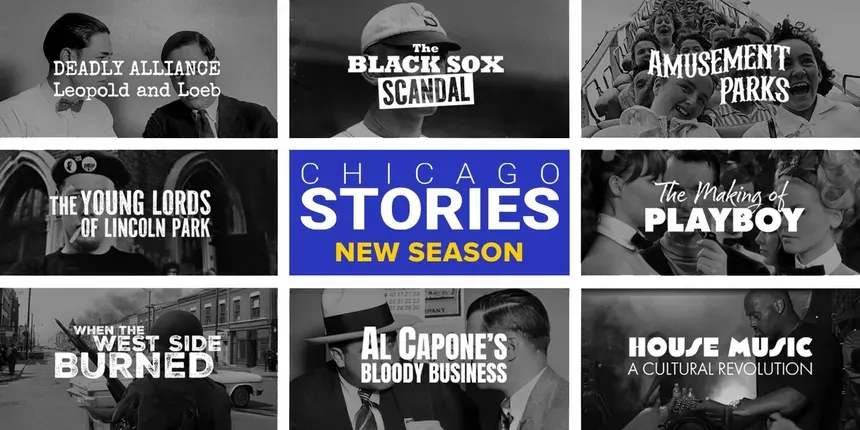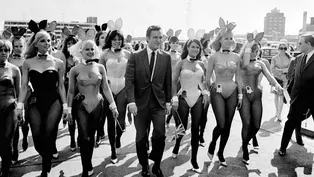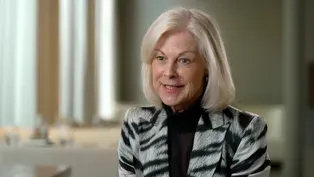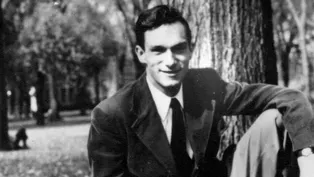Chicago Stories
The Chicago Playboy Club and Hugh Hefner’s Mansion
Clip: 10/18/2024 | 7m 58sVideo has Closed Captions
Hefner opened the first Playboy Club, followed by his mansion, in Chicago.
As the sexual revolution reached new heights, Hugh Hefner opened his Playboy Club – followed by the Chicago Playboy Mansion – in 1960.
Chicago Stories is a local public television program presented by WTTW
Leadership support for CHICAGO STORIES is provided by The Negaunee Foundation. Major support for CHICAGO STORIES is provided by the Elizabeth Morse Genius Charitable Trust, TAWANI Foundation on behalf of...
Chicago Stories
The Chicago Playboy Club and Hugh Hefner’s Mansion
Clip: 10/18/2024 | 7m 58sVideo has Closed Captions
As the sexual revolution reached new heights, Hugh Hefner opened his Playboy Club – followed by the Chicago Playboy Mansion – in 1960.
How to Watch Chicago Stories
Chicago Stories is available to stream on pbs.org and the free PBS App, available on iPhone, Apple TV, Android TV, Android smartphones, Amazon Fire TV, Amazon Fire Tablet, Roku, Samsung Smart TV, and Vizio.

Chicago Stories
WTTW premieres eight new Chicago Stories including Deadly Alliance: Leopold and Loeb, The Black Sox Scandal, Amusement Parks, The Young Lords of Lincoln Park, The Making of Playboy, When the West Side Burned, Al Capone’s Bloody Business, and House Music: A Cultural Revolution.Providing Support for PBS.org
Learn Moreabout PBS online sponsorship- As Playboy Magazine greeted a new decade in business with 1 million subscribers, seismic shifts rocked America for men and women.
The Food and Drug Administration approved the first oral contraceptive - To an age of vigor and vitality, whereas Kennedy would've said "vigah".
- Hefner had donated to John F. Kennedy's campaign and celebrated the president's inauguration in Washington - To really kind of shows in the background the old Eisenhower norms.
Hefner is right in the middle of all of that.
- Hefner brought the magazine to life in 1960, launching a swanky lounge that required a membership key called the Playboy Club, but the city tried to stop him yet again.
- When we opened the first Playboy Club in February of 1960, the city of Chicago didn't want to give us a license.
We had to go to court to get that.
They objected to the bunny and they objected.
First and foremost, I think simply to the concept of Playboy.
- Hefner won that round too.
The Playboy Club was an instant success and expanded quickly to other cities.
- I loved meeting people when they came in and seeing where they're from, what they came there for.
- Bunnies fitted in satin corsets and cotton tails served cocktails in four different rooms.
Marli Renfro made her way to Chicago after playing Janet Lee's body double in "Psycho."
She posed for Playboy and found work at the new club.
- You go to any bar in town and a mixed drink was 35 cents.
The Playboy Club charged a dollar 50.
Nobody complained.
- It was a great place to entertain somebody coming in from out of town and they loved it.
There's always that prospect, wow, what might, what might happen if I go there?
- Playboy integrated its clubs boosting the careers of comedian Dick Gregory and other African American performers.
Gloria Johnson was looking for a change when she was invited to become the first black bunny.
Three years before the Civil Rights Act banned workplace discrimination.
- The biggest room was the living room.
We would take our three inch heels off and get on that top of that piano and do our go, go do our dancing up there.
You know, - Hefner's Brother Keith developed a 44 page bunny manual.
It included demerits for chewing gum or dawning a scruffy tail.
- There was like a things you had to remember for drink orders, and I had a, I had a bad memory, so that didn't work for me.
But you know, they would teach you things like the bunny dip.
- If you go down, arch your back like that, it brings you much closer to the table.
- Well, the bunny dip is the way you serve a drink.
You know, you wouldn't wanna like bend over, right?
With the way we were dressed in our little costumes, we had to be ladylike, so we had a certain posture.
It was a job that required a dedication and hard work, - The manual for bid bunnies from dating customers unless they were VIPs.
- So he hired, this is a private detective agency called Wilmar, and they would come in and they would actually hit on the girls, you know, just to make sure that the girls were not dating the members.
It's so funny because people would say, oh God, Wilmar is in the house.
Girls, Wilmar is [Laughter] - Someone else was posing undercover at New York City's Playboy Club feminist icon.
Gloria Steinem made her mark as a young journalist when she worked as a bunny for a 1963 magazine expose.
Steinem described a sexist environment that exploited and demeaned women.
She wrote about toiling for long hours at minimum wage, constant propositions and mandatory venereal disease exams.
- So Hefner wrote her a letter after the article came out saying, okay, I'm taking that out of the requirements for the Bunnies.
Steinem's article actually had a huge effect - For Johnson, the job was well worth it.
for the first time in her life and make lasting connections.
- Playboy represented family to me.
It was the closest thing that I had ever felt to ever really belonging to anything.
- Lines stretched down Michigan Avenue, even when temperatures sank below zero.
There were 50,000 members by the end of the first year making it America's hottest nightclub.
Al Capone was no longer Chicago's most famous renegade, - And Chicago became Playboy.
- Big time.
- Hefner heightened the mystique when he opened the Playboy mansion just blocks away in the Gold Coast.
A brass plaque at the front gate bore a Latin inscription that said it all.
- If you don't swing, don't ring.
The butler opens the door, and then you go in around the corner and you're in the main ballroom.
It was like I was in a castle of a king.
There was a Picasso above the fireplace.
- Hefner utfitted the mansion with hidden passages, cutting edge electronics and other toys, including a bowling alley and a game room where he played pinball, monopoly and foosball all night long.
Fantastic.
- You'd slide down a fireman's pole in the living room to get to the underground pool, and then there was a big window where guests at a bar could watch the swimmers in the pool while they had cocktails.
It was unbelievable.
- There's a picture of Christa Speck jumping into the pool topless.
That was like one, 250th of a second, and everyone who saw Playboy in the sixties remembers that image.
- I remember taking my mom there, and she did say, that's a funny place to put a mirror.
My mom was so naive.
- Chefs offered 24 hour room service to guests and the two dozen bunnies who bunked at the mansion.
- A lot of the girls worked late at like three o'clock in the morning.
You can come and order lobster from the kitchen, and I mean anything.
Your heart desired it.
He was a good host.
- Hefner could have eaten lobster and caviar every night, but never outgrew his mother's recipes.
- Hefner, I wonder if we could get something to eat.
- Pot roast and meatloaf, - Maybe a couple of ham sandwiches.
- He had really down to earth taste.
- Hefner was often compared to F Scott Fitzgerald's protagonist, Jay Gatsby opening his mansion to everyone from Barbara Streisand to Tony Curtis.
- He had the Rolling Stones there that stayed and trashed a couple of rooms and then weren't invited back again.
Those guys, I'm telling you.
The End of Playboy’s Chicago Era
Video has Closed Captions
Playboy’s time in Chicago comes to a close. (9m 2s)
Extended Interview: Christie Hefner
Video has Closed Captions
Christie Hefner, Hugh Hefner’s daughter, talks about her father and Playboy’s philosophy. (5m 49s)
Hugh Hefner and the Origins of Playboy
Video has Closed Captions
Hugh Hefner began Playboy magazine from his apartment in Chicago. (7m 4s)
Providing Support for PBS.org
Learn Moreabout PBS online sponsorshipChicago Stories is a local public television program presented by WTTW
Leadership support for CHICAGO STORIES is provided by The Negaunee Foundation. Major support for CHICAGO STORIES is provided by the Elizabeth Morse Genius Charitable Trust, TAWANI Foundation on behalf of...















